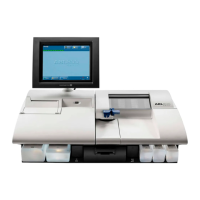1. Potentiometric measuring principles ABL800 FLEX Reference Manual
Electrolyte electrodes, Continued
Drift (continued) Cl electrode
)Cal1(Cl)prevCal1,(Cl101(Cl)Drift
prev)Sens(Cl,61.5-
prev)Cal1,E(Cl,Cal1)E(Cl,
−−
×
−
−×= cc mmol/L
)(Cal2Cl)prevCal1,(Cl102(Cl)Drift
prev)Sens(Cl,61.5-
prev)Cal1,E(Cl,-Cal2)E(Cl,
−−
×
−×= cc mmol/L
NOTE: If Cal 1 solution bottle has not been changed between two consecutive
calibrations, the cX(Cal1,prev)
−
cX(Cal1) = 0, where X is the respective
electrolyte ion.
The default drift tolerances set by Radiometer are as follows:
Electrode Drift 1 Tolerances Drift 2 Tolerances
K
± 0.2 mmol/L ± 1.5 mmol/L
Na
± 3 mmol/L ± 1 mmol/L
Ca
± 0.05 mmol/L ± 0.2 mmol/L
Cl
± 2 mmol/L ± 3 mmol/L
Measurement
The electrolyte concentration in a sample is calculated from the following
equation:
)prevSens(X,Sens(theo)
prev)Cal,E(X,-sample)E(X,
101) X(CalX(sample)
×
×=cc
where:
E(X,sample) = Potential of the electrolyte electrode chain from a
measurement on the sample.
E(X,Cal,prev) = Potential of the electrolyte electrode chain from the
previous calibration on Cal 1 solution.
cX
(Cal 1)
=
Specific (true) concentration of the electrolyte ion in Cal 1
solution.
Sens
(theo) = Theoretical sensitivity of the electrolyte electrode.
Sens(X,prev) = Relative sensitivity of the electrolyte electrode chain from
the last 2-point calibration.
Continued on next page
1-28

